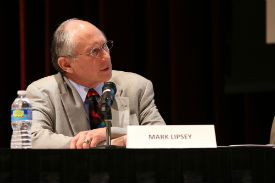
When Professors Dale Farran and Mark Lipsey released their report on Tennessee’s Voluntary Pre-K (TN-VPK) program in the fall of 2015, it sparked discussion in education circles around the world and generated coverage in The New York Times, U.S. News &World Report, The Los Angeles Times and elsewhere. The first rigorous, controlled longitudinal study conducted on a large-scale, state-funded pre-K program, the “TN-VPK Effectiveness Study” set out to determine if Tennessee’s prekindergarten program was effective at preparing students for educational success.
What researchers found was that although children who enrolled in the state’s program were better prepared for kindergarten than those not enrolled, by the third grade, the children who had pre-K had fallen behind their peers who were not participants. The researchers’ conclusions prompted the Tennessee Department of Education to institute a thoughtful review of its approach to Voluntary Pre-K, which was designed to serve thousands of children from economically disadvantaged families.

Dale Farran, co-principal investigator and the Antonio M. and Anita S. Gotto Professor of Teaching and Learning at Vanderbilt’s Peabody College of education and human development, says, “The problems that pre-K is supposed to address are very real. The achievement of children from low-income families is increasingly diverging from that of higher income families,” she says. “While the findings of one study of the sustained effects of a state pre-K program should not be over-interpreted, we are concerned about what will happen to the needs of poor children when the programs being implemented do not show the promised results.”
Because Tennessee’s state-funded pre-K does not mandate use of a single curriculum across the state, the researchers have suggested developing a standard for the state’s pre-K programs, building on the work of the strongest. In response to the study’s findings, the issue for the state will be how to carry out those changes across so many school districts. The aim is to better prepare pre-K students for school and improve kindergarten and elementary school.
“The question is, can we define what a statewide prekindergarten program is or should be?” says Mark Lipsey, director of the Peabody Research Institute (PRI) and Farran’s co-principal investigator. “States are doing remarkably different things—with curricula, class size, teacher qualification, and so on—and calling all of it pre-K. And almost none of the states invest in monitoring their pre-K programs once they’re in place.”

In Tennessee, for example, varying quality of pre-K classrooms is a challenge. The state introduced Voluntary Pre-K in 1996 to help economically disadvantaged children advance academically. In 2005, the program expanded to serve 18,000 Tennessee children in 935 classrooms across all 95 counties. But the quality, practices, and curriculum vary widely from site to site.
Because the state has been reluctant to expand its program, local districts have moved on their own to expand pre-K offerings, adding another layer of complexity. Metro Nashville Public Schools launched three new early-learning centers to serve 520 prekindergarten low-income students in the fall of 2014. Working with researchers from PRI, center directors and teachers are developing an academic program rooted in play, experiential learning, and discovery. The aim is to build strong foundations in math and reading, with additional focus on the arts, science, and social and emotional skills. The hope is that these model programs will provide a blueprint for pre-kindergarten for the district.
In light of TN-VPK findings, the Tennessee Department of Education is considering revisions to its programs.
“Our first priority is ensuring our strategies are informed by evidence of student progress,” says Lisa Wiltshire, executive director of the department’s Office of Early Learning, “To that end, we are currently developing a Kindergarten Entry Screener to assess incoming kindergarteners’ academic and social-emotional development. This information will be used to guide kindergarten instruction, as well as program improvement in preschool. Additionally, we are continuing to develop a pre-K and kindergarten portfolio evaluation option for teachers that focuses on critical areas of student growth aligned to the Tennessee Early Learning Developmental Standards. We intend to offer the same option for teachers in first grade, and we are looking at an optional second grade assessment.”
The state will also use PRI’s evaluation of expansion classrooms and services from Metro Nashville and Shelby County programs under the U.S. Department of Education’s Preschool Development Grant, as well as national research and best practices from excellent programs in Tennessee, to create standards that define high-quality early learning. Program monitoring and continuous improvement and professional development standards for pre-K to third-grade teachers and school administrators are also planned.
“We believe these strategies, in combination with a targeted focus on early foundations and literacy, pre-K to third grade, will result in diminished variation between programs and a higher standard of program quality across the state,” Wiltshire says
In the wake of the TN-VPK study, some state legislators have discussed the possibility of scrapping Voluntary Pre-K. At the federal level, lawmakers have debated whether to fund the Obama administration’s Preschool Development Grants but retained them in legislation reauthorizing the Elementary and Secondary Education Act. Farran, Lipsey, and proponents of pre-kindergarten programs argue that reducing or eliminating preschool programs would be unwise. In November 2015, the Southern Regional Education Board released a report on early childhood education that reviewed the earlier pre-K studies and recommended states invest in areas such as accountability, access, and program and teacher quality rather than abandoning their programs.
Despite the lack of evidence about the effectiveness of statewide implemented programs, the SREB report contends that, “We know the costs if we don’t invest now. We’re already paying them, in fact, when children need extra services to stay on track in elementary school. When teenagers drop out. When citizens remain unemployed, and our tax revenues shrink. And when health care, welfare and criminal justice demand large shares of our state budgets.”
In “Evidence for the Benefits of State Pre-Kindergarten Programs: Myth and Misrepresentation,” a draft study to be published in Behavioral Science and Policy in 2016, Farran and Lipsey review more recent studies of statewide pre-k programs and conclude that little can be generalized from them because they are uniformly poor methodologically. There is a great need for more rigorous data to provide states with the information they need to institute the programs.
Lipsey and Farran suggest that much work needs to be done to determine critical aspects to define high quality in pre-K, but quality, even if better defined, cannot suffice alone. Pre-K should be integrated with kindergarten and elementary curricula to support cumulative learning and maintain gains made in early education.
Helping low-income children close the education gap is the potential pre-K programs like Tennessee’s strive to fulfill. With a program in place, the work at hand is to apply what has been learned from its success as well as its shortcomings to ensure it succeeds.